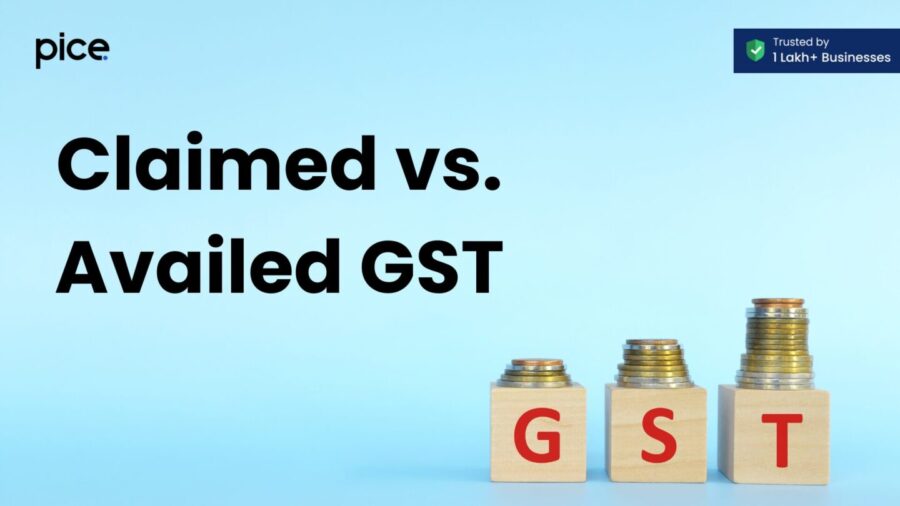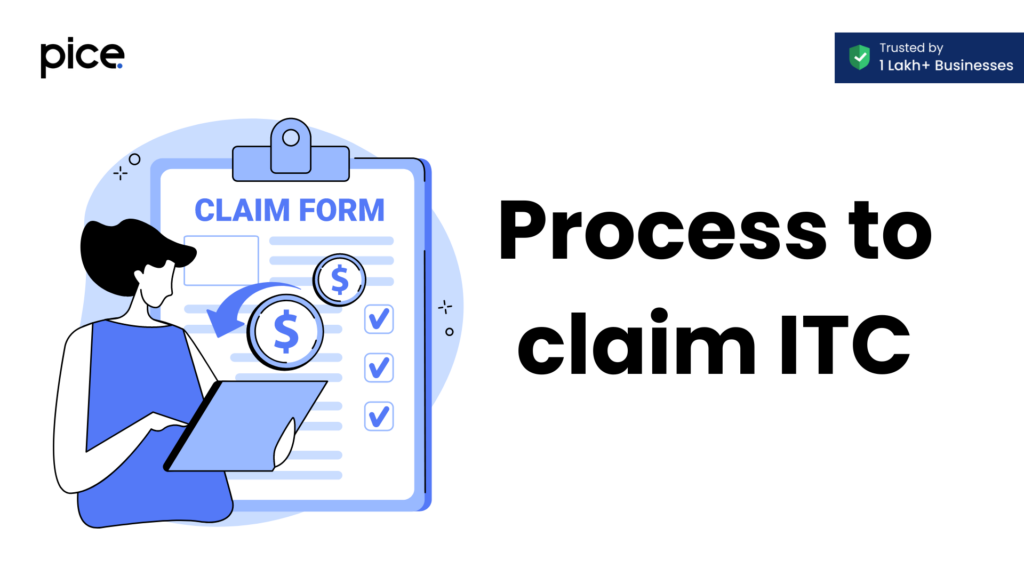Claimed vs. Availed GST
- 26 Aug 24
- 10 mins

Claimed vs. Availed GST
Key Takeaways
- Input Tax Credit (ITC) allows businesses to claim the GST paid on purchases and expenses, which helps in reducing the overall tax liability on outward supplies.
- To claim ITC, businesses must have valid tax invoices, ensure receipt of goods or services, make timely payments, and reconcile with GSTR-2A and GSTR-2B.
- Only registered persons under GST can claim ITC, and it must be for goods or services used in taxable supplies and business purposes.
- Availing ITC involves recording eligible credits in the electronic credit ledger and using them to offset output tax liability, ensuring compliance with GST laws.
- Claimed ITC is the credit reported in GST returns, while availed ITC is the credit recorded in the electronic credit ledger and ready to be utilized against tax liabilities.
What is Input Tax Credit?
Input Tax Credit (ITC) is a mechanism under the Goods and Services Tax (GST) that allows businesses to claim credit for the GST paid on purchases or expenses incurred in the course of business. The ITC system ensures a seamless flow of credit across the supply chain, preventing the cascading effect of taxes and ultimately reducing the tax burden on end consumers.
To understand ITC better, let's break it down:
- Tax Component: ITC includes the tax component paid on both goods and services used in the business. This includes raw materials, capital goods, and services.
- Valid Tax Invoice: A registered person must have a valid tax invoice to claim ITC. This invoice must comply with the GST law requirements and should be issued by a registered supplier.
- Input Service Distributor: Businesses with multiple branches can distribute ITC among branches using the concept of an Input Service Distributor (ISD).
- Credit On Capital Goods: ITC can be claimed on capital goods, enhancing the cash flow and reducing the capital cost for businesses.
- Annual Return: ITC claims must be reported accurately in the annual return to ensure compliance and avoid penalties.
Understanding ITC is crucial for businesses to optimize their tax liabilities and improve cash flow management.
How to Claim ITC?

Claiming ITC involves several steps that must be followed meticulously to ensure compliance with GST laws. Here's a step-by-step guide on how to claim ITC:
- Possession of a Tax Invoice: Ensure you have a valid tax invoice or debit note issued by a registered supplier. This invoice must contain all required details, including the GSTIN of the supplier and recipient, and the amount of GST charged.
- Receipt of Goods or Services: You must have received the goods or services for which you are claiming ITC. In the case of job work, ITC can be claimed when goods are sent to a job worker.
- Payment of Invoices: The payment for the supply must be made within 180 days from the date of the invoice. Failure to do so will result in the reversal of ITC.
- Filing GST Returns: Regularly file your GST returns, including GSTR-1 and GSTR-3B. The details of ITC claimed must be accurately reported in these returns.
- Reconciliation with GSTR-2A: Ensure that the ITC claimed matches the details available in GSTR-2A, which is auto-populated from the suppliers' GSTR-1. Any discrepancies must be addressed through GSTR-2A reconciliation.
- Form GSTR-2B: Use Form GSTR-2B for a consolidated view of ITC available for the tax period. This helps in matching the ITC claimed with the credit available.
- Maintain Documentation: Keep all relevant documents, such as purchase registers and payment records, for audit purposes.
Following these steps ensures that the ITC claimed is valid and compliant with GST laws, thereby reducing the risk of penalties and interest on excess credit claimed.
Who Can Claim ITC?

ITC can be claimed by any registered person under GST who meets the eligibility criteria. Here are the key conditions for claiming ITC:
- Registered Person: Only a registered person under GST can claim ITC. This includes regular taxpayers, composition scheme taxpayers (limited to certain conditions), and ISDs.
- Use for Business Purposes: The goods or services on which ITC is claimed must be used for business purposes. ITC cannot be claimed for goods or services used for personal or non-business purposes.
- Taxable Supplies: ITC can only be claimed on supplies used to make taxable supplies, including zero-rated supplies. ITC cannot be claimed on exempt supplies.
- Payment of Tax: The tax charged by the supplier must be paid to the government, either through cash or by utilizing the credit available in the electronic credit ledger.
- Credit Under GST: ITC cannot be claimed on the credit of tax paid under the Composition Scheme, as these taxpayers are not eligible for ITC.
- Health Services and Motor Vehicles: ITC on health services and motor vehicles is restricted unless used for specified purposes such as furtherance of business.
By meeting these conditions, businesses can ensure they are eligible to claim ITC and optimize their tax liabilities effectively.
Availing ITC
Availing ITC is an essential aspect of GST compliance that involves systematic tracking and documentation. Here are key points to consider when availing ITC:
- Time Limit: ITC must be availed within the time limits prescribed under GST law, typically before the filing of the annual return or the due date for September of the following financial year, whichever is earlier.
- Monthly Returns: Regular filing of monthly returns such as GSTR-3B is crucial for availing ITC. This ensures that the claimed ITC is accurately reflected in the returns.
- Reversal of ITC: In cases where goods or services are used for exempt or non-business purposes, ITC must be reversed. This includes ITC on health insurance used for employees not mandated by law.
- Excess Credit: Any excess credit claimed must be reversed along with interest. Proper reconciliation with purchase registers and GSTR-2A helps in identifying and rectifying excess credit.
Effective availing of ITC requires diligent record-keeping and timely compliance with GST regulations to avoid penalties and optimize tax liabilities.
💡If you want to pay your GST with Credit Card, then download Pice Business Payment App. Pice is the one stop app for all paying all your business expenses.
How to Avail ITC
Availing ITC involves a detailed process to ensure compliance with GST laws. Here are the steps involved:
- Maintain Accurate Records: Keep accurate records of all purchases and expenses eligible for ITC. This includes maintaining a purchase register and keeping copies of all valid tax invoices.
- Regular Reconciliation: Regularly reconcile your purchase records with GSTR-2A and GSTR-2B to ensure that the ITC claimed matches the credit available.
- Use of ITC: Utilize the ITC available to offset your output tax liability. This includes adjusting ITC against the GST payable on taxable supplies made during the tax period.
- Timely Filing: File your GST returns on time, ensuring that the ITC claimed is accurately reported in GSTR-3B. Late filing can result in the loss of ITC for the period.
- Compliance with Rules: Follow the rules and guidelines laid down under GST law for claiming and utilizing ITC. This includes complying with conditions for claiming ITC on capital goods, job work, and transfer of business.
By following these steps, businesses can ensure they avail ITC effectively and maintain compliance with GST regulations.
Basic Difference Between Claimed and Availed
The terms "claimed" and "availed" ITC often cause confusion. Here’s a clear distinction:
- Claimed ITC: ITC that is claimed in the GST returns based on the eligible purchases and expenses incurred during the tax period. This includes ITC on taxable supplies, capital goods, and input services.
- Availed ITC: ITC that is utilized to offset the output tax liability in the GST returns. This includes using the claimed ITC to reduce the net tax payable to the government.
The key difference lies in the application of ITC:
- Flow of Input Credit: Claimed ITC is recorded in the electronic credit ledger, while availed ITC is applied to offset the tax liability in the return filing process.
- Compliance: Both claimed and availed ITC must comply with GST regulations, including maintaining valid tax invoices, timely filing of returns, and proper reconciliation with GSTR-2A and GSTR-2B.
Understanding this difference is crucial for businesses to manage their GST liabilities and ensure seamless compliance with GST laws.
 By
By 

















